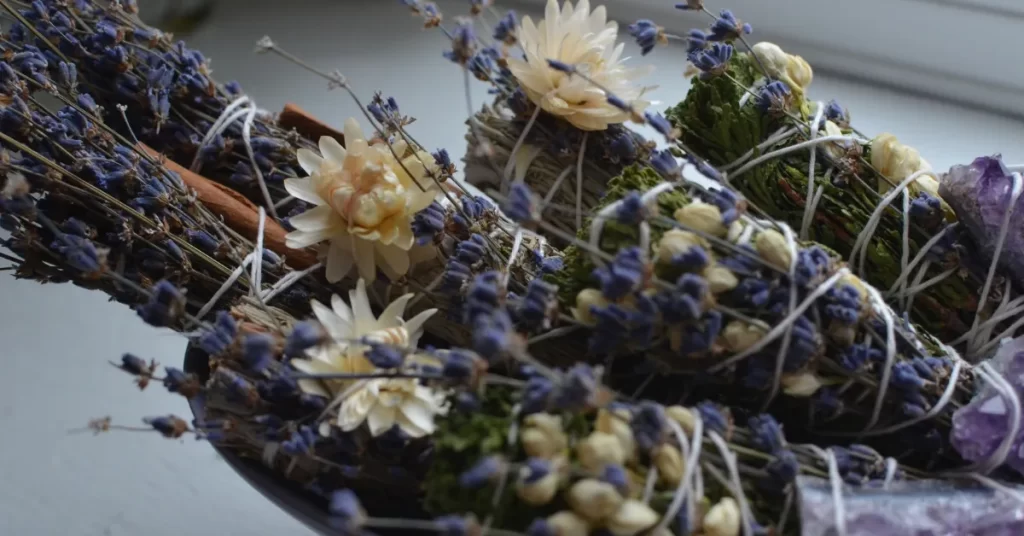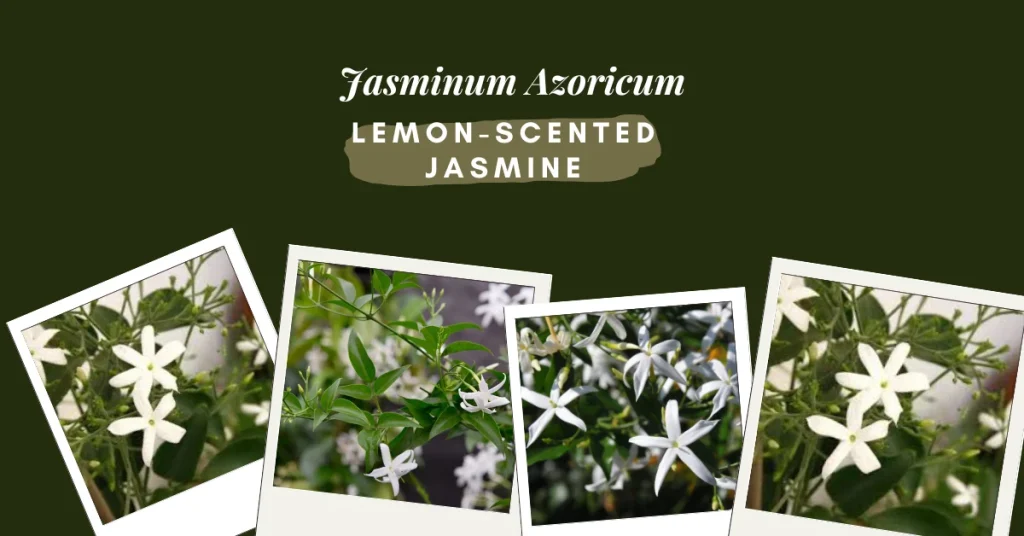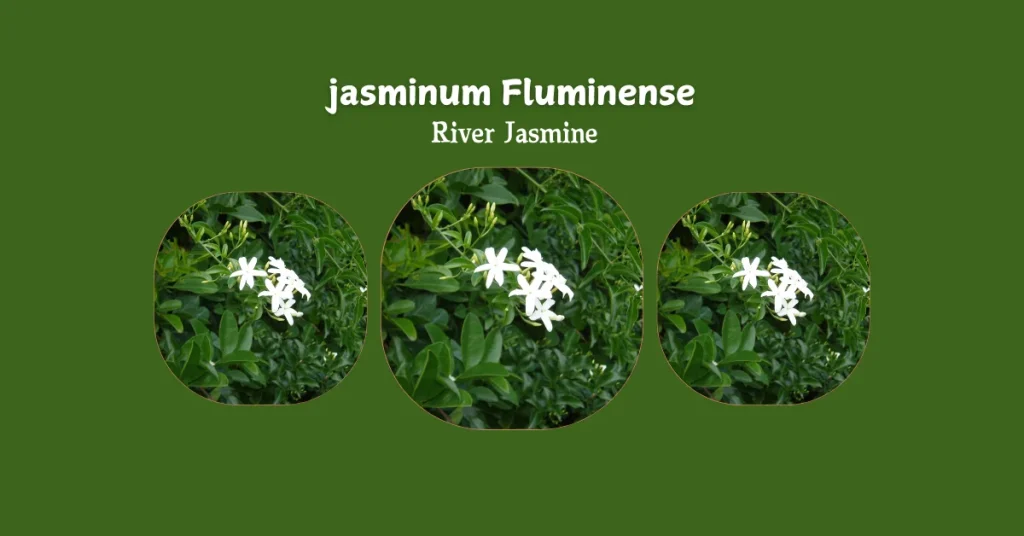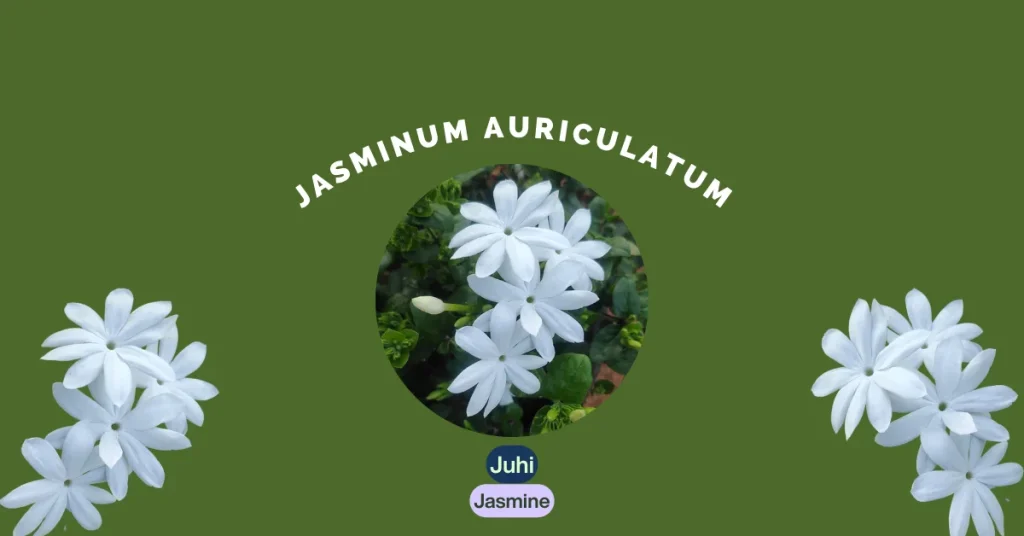Jasmine vs Gardenia:Similarities and Differences
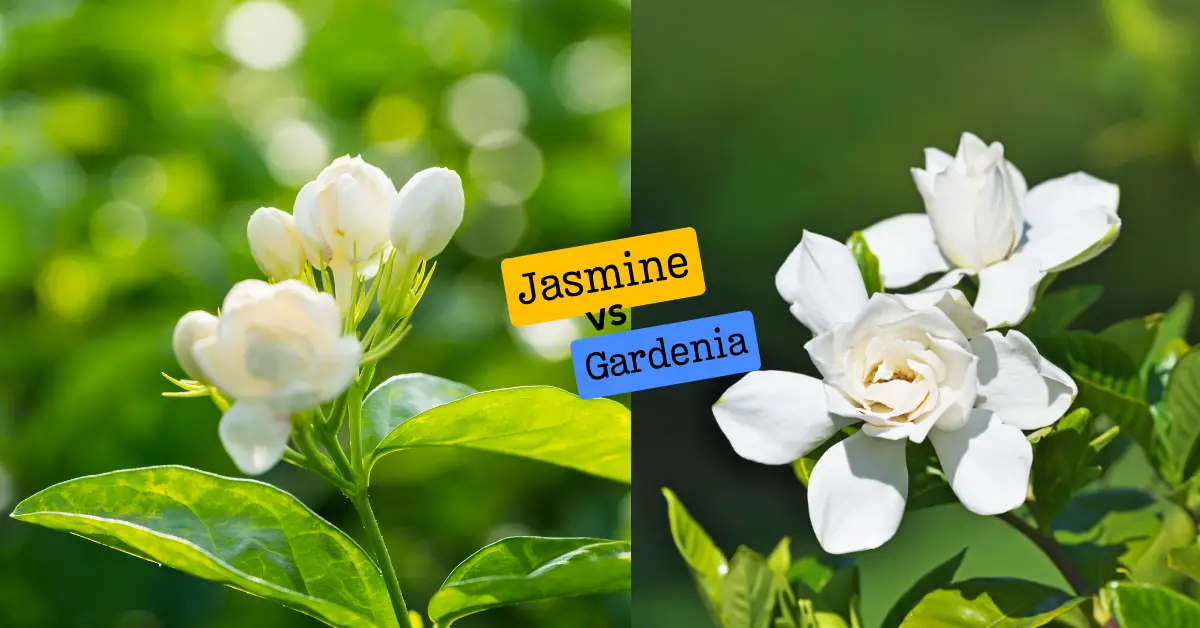
Flowers are a fascinating world filled with various species, each exhibiting its unique characteristics and scents. Two of the most popular choices are Jasmine and Gardenia, which can be found in gardens, bouquets, and perfumes. Due to their intense aromas and similar white flowers, Gardenias and Jasmines are frequently confused.
Basically, they smell the same and have similar leaves, and it can be challenging to differentiate between them. Despite their similarities, gardenias and jasmines are different plant types, grow in different environments, and produce different flowers and scents. Let’s take a closer look of these two floral wonders and discover their similarities and differences. You can find out everything you need to know about jasmine vs gardenia here.
Comparative Analysis: Jasmine vs Gardenia
| Characteristics | Jasmine | Gardenia |
| Botanical Family and Genus | Oleaceae, Jasminum | Rubiaceae, Gardenia |
| Flower Color | White | Creamy White |
| Leaf Structure | Compound leaves | Simple, glossy leaves |
| Flower Form | Star-shaped clusters | Rose-like, single blooms |
| Blooming Pattern | Year-round (varies) | Seasonal, occasional |
| Climate Preferences | Adaptable | Subtropical, warm climates |
| Soil Requirements | Well-draining, neutral | Well-draining, acidic |
| Culinary Uses | Jasmine tea and recipes | Limited culinary uses |
Similarities Between Gardenia and Jasmine
Having gardenia and jasmine in the backyard is a wonderful experience. Most of their extracts are used to create perfumes with a flowery scent. Both gardenias and jasmines have white flowers and an intense scent.
Also, they are both versatile plants with a variety of uses due to their fragrances. The similarities between Gardenia and Jasmine make it a more relevant comparison. The following are some of them.
The Fragrance
Both Jasmine and Gardenia are known for their intoxicating scents. They are popular choices in perfumes, essential oils, and scented candles because of their sweet and heady scent.
Versatile Uses
They are both versatile in their applications. It is common to use jasmine and gardenia in floral arrangements and bouquets at weddings and religious ceremonies. It is their timeless beauty and fragrance that make them so popular as decor choices for a variety of environments.
A white Bloom
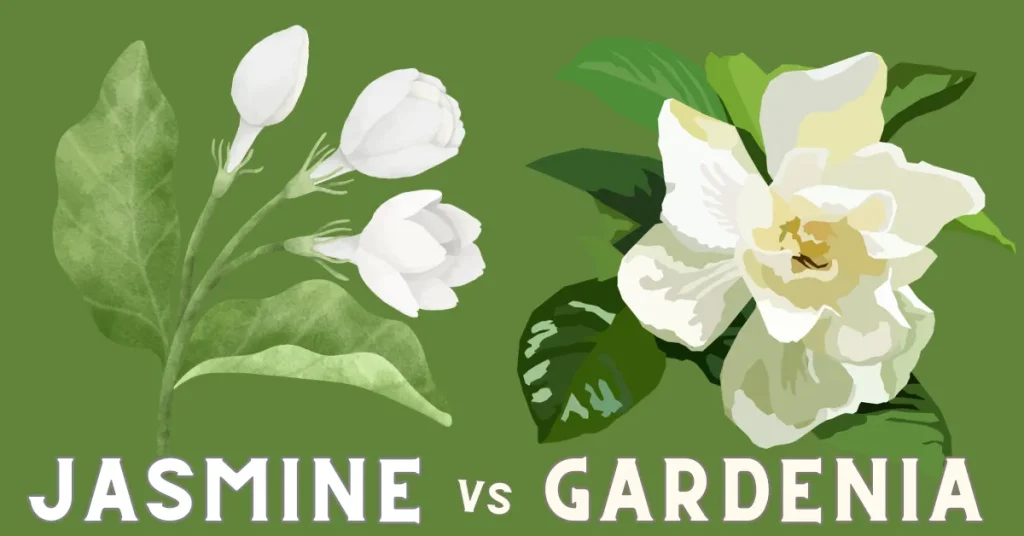
Gardenia and Jasmine share the same color of blossoms. There is an elegance and purity associated with both flowers due to their pristine white petals.
Edible
The both plants are edible. Especially, chameli flower has more uses whether as medicinal plant or in different recipes. It is also common to dry and preserve both plant petals and make tea from them.
Differences Between Jasmine Flowers and Gardenias
Group and Family
Even though both plants are members of the tracheophytes group, they are not related. Jasmines belong to the Oleaceae family, while gardenias are members of the Rubiaceae family.
Rubiaceae plants can be found in most parts of the world. This means that plants that belong to this family are most abundant in the tropics and subtropics.
Jasmine, however, belongs to the Oleaceae family, also known as the olive family. Even though this family contains fewer plants than Rubiaceae, it includes a tree that bears a fruit that is loved by all of us: the olive tree.
Planting Season
Both of these flowers bloom all year long once they are planted. There are, however, significant differences between how and where these plants should be planted for best propagation.
Jasmine, however, is normally planted in the spring. In this way, they have an entire spring and well into the fall to grow, reproduce, settle, and bloom. Jasmine grows as twining vines, so you will need a structure to support them, such as an arbor or a trellis; otherwise, they will droop and not propagate well.
Unless you live in Zone 8 or another warm region, gardenias should be planted in the fall. Plant them in the spring if you live in a cooler climate, such as USDA Zone 7. Gardenias should be planted in the spring before the weather turns cool so that they can settle into the soil. When the cold weather ends you can expect your gardenias to grow back and bloom again once the cold weather ends.
Season of Flowering
Jasmines bloom from spring to fall, though their flowering season is slightly longer than that of gardenias. Beginning in August, gardenia flowers tend to taper off into the fall.
Neither of these flowers can bloom at the same time. Jasmine has a long season, which might last until November. The branch will produce more than three blossoms, and the blooms will not disperse. The first bud appears in spring when jasmine blooms. Following the blooming season, the calyx splits into roughly eight parts, and the buds become spherical. Additionally, there are both single and double valves on Jasmine. Its single petals are silky as well, tubular in shape.
The gardenias are different. The blooming season for gardenias is short and flies by as the year progresses. In contrast to jasmine, each brand only contains one blossom. A flat pinwheel pattern is formed by its pointed bracts pointing in five directions.
Stems & Branches
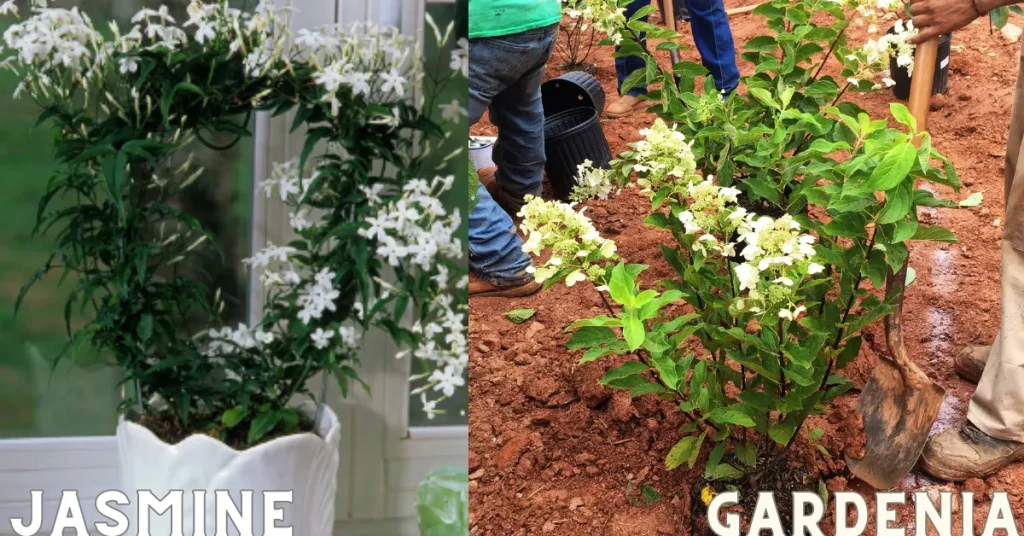
One of the most noticeable differences between gardenias and jasmines is their stems and branches. Gardenia bush stems are grayish, and it grows as a shrub. In contrast, jasmine has darker stems and vine-like branches that grow vertically against surfaces like walls and fences.
Both plants grow well as shrubs. However, the plants require different care and propagation. Jasmines are semi-vining shrubs that climb trellises and grow about five to ten inches a year. To ensure the propagation and growth of the plants, they will need to be pruned frequently.
To keep gardenias from spreading too far, they must also be pruned. When the plant is newly planted, pruning should only be done after it has finished flowering. Compared to older plants, young gardenias require more pruning.
Leaves
The leaves of gardenias and jasmines are one of their most distinctive characteristics. Leaves of the jasmine plant are ovate in shape and measure 2-3 cm in length. Leaves of jasmine are narrow and dark green. This flower has long petals and stubby leaves, which seem out of proportion to its delicate leaves.
Gardenias have longer leaves than other plants. Their length can reach 12 centimeters. Gardenia and jasmine vines can be distinguished easily by this characteristic. It has a more vibrant color and a tougher and mature texture. Jasmine leaves are round and have a toothed edge, whereas gardenia leaves are pointed and smooth.
The Fruits
Gardenias and jasmines produce fruit, as well as flowers of both types. Both blooms produce vastly different fruits. Jasmines, as you have noticed, are delicate and small. The same applies to their fruit. Their shape is spherical, and they are relatively small. Though they are not edible, their purple color and texture make them appealing.
In contrast, Gardenias produce fruits that are unresembling their flowers. They are globular and orange in color. Fruit sizes can also vary significantly. Some gardenias have fruits that are just 1 or 2 centimeters wide, while others measure up to 10 centimeters.
Fragrance
Gardenia and jasmine have different scent profiles as well. People are typically able to identify the distinct scent of both once they have become familiar with them. Gardenias and jasmine are both heavily used in perfumery. However, gardenias have a much more pungent smell than jasmine and can overpower homes if planted close to living spaces.
The scent of jasmine is much more indolic than the scent of gardenias, but gardenias have a much more potent scent. There is a sweet undertone to the fragrance of jasmine. It smells so earthy and pleasant. Tropical aromas are characteristic of gardenias. Some people report gardenias smelling like rootbeer or wintergreen.
To Sum Up
The unique and unforgettable plants living on our planet are endless, whether you’re adding a plant to your garden or identifying a plant already there. There’s no real wrong choice with either plant, so the decision comes down to your personal preferences, primarily in terms of its height (and width) and scent. Though gardenias and jasmines look alike, they require different care and techniques. Your living space can be enhanced by these beautiful plants as garden or houseplants.
Most people wonder which flower smells better – jasmine or gardenia. The answer is ambiguous. A flower lover will find both flowers enticing because of their distinctive fragrances. Jasmines and gardenias require specific care and attention in order to thrive in their cultivated environments.

I am Yasir Riaz, an Agronomist for more than a decade. Helping local farmers and Gardeners to improve their crops and Gardens and overall productivity. In addition to my work in agriculture, I have also delved into the digital world as an SEO writer and blogger. Through my blog, I aim to educate and inspire others about the Chameli Flower (Jasmine).

